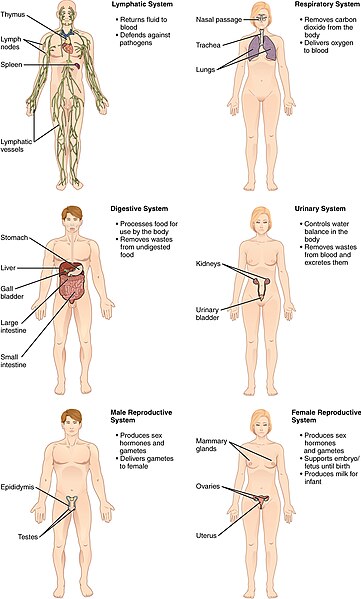HUMAN BODY SYSTEMS
Learning Objectives
By the end of this section, you will be able to:
- Identify the 11 systems of the human body and their functions
- Identify key organs and tissues of various body systems
In multicellular organisms, cells specialize to perform certain tasks. A group of cells together form tissues, which in turn make up organs, and then systems. For example, cardiac tissue is made up of cardiac muscle cells, and the tissue comes together to make an organ, the heart! The heart is, in turn, part of the cardiovascular system.
| System | Organs/Tissues | Function |
| Circulatory (Cardiovascular) | heart, arteries, veins, capillaries, blood | carries oxygen, carbon dioxide and nutrients |
| Digestive | mouth, esophagus, liver, stomach, small intestine, large intestine, anus | Ingests and digests food, to get nutrients, and eliminates waste |
| Endocrine | thymus, adrenal gland, pancreas, hypothalamus, pituitary gland, thyroid gland | maintains homeostasis |
| Integumentary | hair, skin, nails | protects body from injury, infections and other external factors |
| Lymphatic | lymph nodes, thymus, spleen, appendix, bone marrow | returns fluid to the body, and contributes to immunity |
| Muscular | skeletal muscles | movement and posture |
| Nervous | brain, spinal cord, nerves | detect stimuli and directs responses |
| Reproductive (male and female) | females – ovaries, uterus, vagina
males – prostate gland, seminal vesicles, vas deferens, penis, testis |
produces sex hormones and gametes for reproduction |
| Respiratory | lungs, trachea, larynx, pharynx, nasal cavity | supplies blood with oxygen and eliminates carbon dioxide |
| Skeletal | bones, cartilage | movement, protecting organs, giving shape and size to the body |
| Urinary | kidney, bladder, ureter, urethra | removes waste from blood and excretes urine, regulates pH and chemicals of blood |


Summary
The human body is comprised of a number of different systems, each responsible for specific tasks, but working together to maintain homeostasis.
Media Attribution
- Figure 3.15 & 3:16 Betts, G. J., Young, K. A., Wise, J. A., Johnson, E., Poe, B., Kruse, D. H., Korol, O., Johnson, J. E., Womble, M. & DeSaix, P. (2015). Anatomy and Physiology (section 1.2) . OpenStax. CC BY

